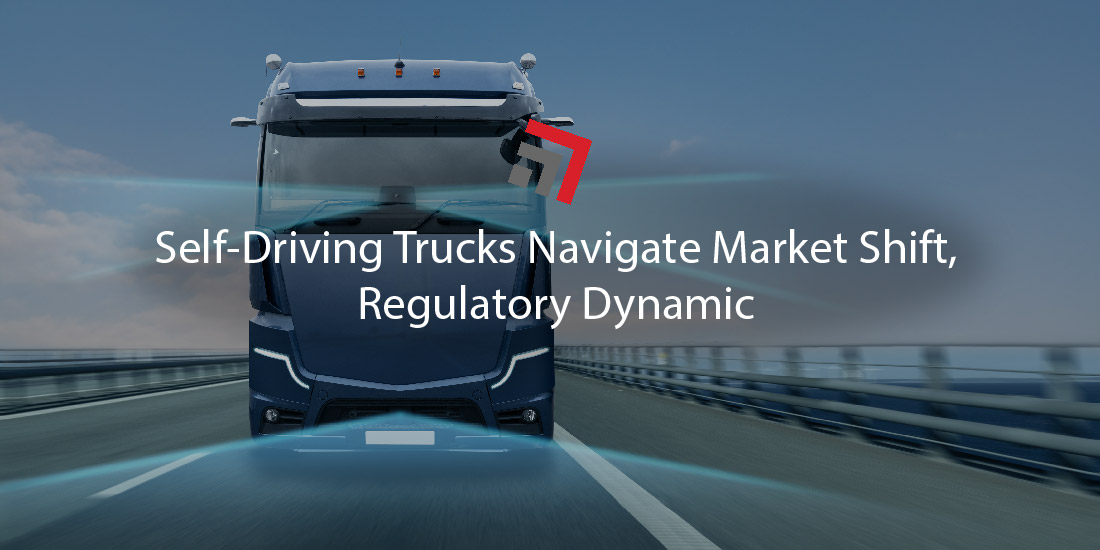It’s possible that the lucrative episodes of heightened freight flow in 2021 and 2022 had an intoxicating effect on the industry regarding its eagerness towards innovative pursuits.
Investments into ambitious technologies were a popular school of thought to have a little over a year ago, because why not?
If the freight kept coming in, the money kept coming in. Such growth, while unprecedented and uncertain when it would regress, enticed stakeholders to think bigger and better about their operations.
In other words, if they weren’t worried about paying their bills or competing for volumes, they could focus their gazes onto bolder frontiers.
One advancement in particular captivated the industry. Autonomous, or self-driving, commercial vehicles.
A fall from the heavens
Over the past two years, self-driving trucks have propelled from being schematics on computer screens to a tangible technology that has actually hit the road.
In December 2021, an self-driving truck startup TuSimple completed a fully-autonomous truck run on open public roads without a human driver.
The trip covered 80 miles from Tucson to Phoenix and was a fleeting glimpse into this technology’s broader application in real-world commerce.
Since then, these ambitious startups, like TuSimple, have had a fair share of setbacks. From exhausted investors to tricky finance issues, the usual problems new tech faces compiled even more as the freight market cooled off in late 2022.
A softer market means less capacity for high-expense and high-risk ventures. The industry went from swinging for the fences with nothing to lose to just wanting to hit a single—a comfortable retention of customers and profit as demand plummeted into an ice age.
California bill would delay driverless trucks until 2031
Aside from capital enthusiasm being curbed, another hurdle self-driving tech faces are regulators.
While government officials have collaborated with startups on preparing procedures and standards for a potential future where robot trucks are a reality on roadways, they’ve also displayed skepticism on the haste of which the technology is being rolled out.
The primary concern is that safety is being undermined when catapulting over such a bold horizon. An unmanned 80,000-pound truck barreling down interstates and coexisting with motorists is not a concern to be trifled with.
Clearly, regulatory oversight throughout the rollout process is necessary in order to ensure that safety remains a priority. However, the debate from there is how regulators will preside over the sector and to what extent will they wield their power.
California, a traditional pacesetter for the rest of the states, has raised a new motion that would directly impact autonomous vehicles from being tested and expanded in the Golden State.
If the proposed Assembly Bill 316 becomes state law, trucks without a human driver will not be allowed on the road until at least 2031.
That means any testing or deployment before that would require an accompanying driver.
Opponents of the bill, including self-driving truck companies, call it premature and point to other states, like Arizona and Texas, where the technology is permitted to operate with no record of fatal crashes or accidents.
“Instead, [AB 316] preserves the status quo: 4,400 lives lost in California last year alone in motor vehicle crashes, overwhelmingly caused by human error,” Autonomous Vehicle Industry Association Executive Director Jeff Farah said.
On the other hand, the Teamsters union lauded the bill: “Do you stand with the working people, or do you stand with big tech, who literally want to create autonomous vehicle technology for one reason only—and that is to eliminate jobs to lower their labor costs.”
Final Thoughts
Bizarrely, California prohibits testing of autonomous vehicles that weigh more than 10,000-pounds.
That said, the state’s lukewarm disposition to self-driving tech renders it already not ideal for autonomous vehicle companies to test and deploy their services.
However, if AB 316 does become state law, it sends a clear message to this ambitious tech that it’ll be an uphill battle to make inroads to its freight market and lanes of travel.
Please contact us if you have any questions regarding this topic or any others in cross-border logistics. In addition, stay up to date with weekly headlines from both trucking and rail via our Road Map newsletter.
More blogs similar to this:



Recent Comments